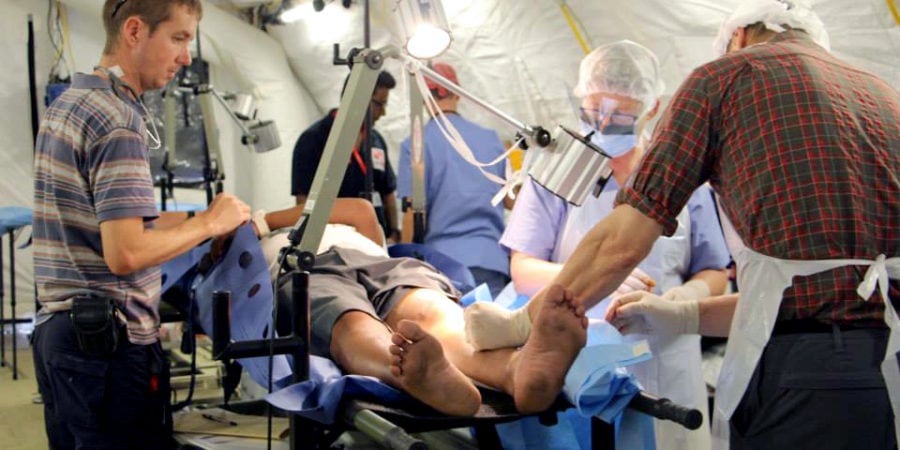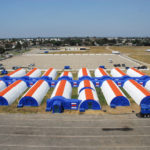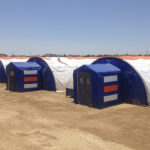US Army Pacific (USARPAC) “Going in Light” Research Discusses Viability of Rapid Deployment Medical Component to Support Humanitarian Assistance / Disaster Relief (HA/DR)
Australia’s National Critical Care and Trauma Response team provides life-saving surgeries in a BLU-MED® mobile medical facility following Typhoon Haiyan in Tacloban, Philippines (2013).
A 2016 research article written by the United States Army, Medical Operations and Planning Office, discusses the viability and need for light-weight, highly adaptable, and mobile medical facilities to support a “Going in Light” strategy for developing a rapid emergency medical response capability. The comprehensive study recognized BLU-MED Response Systems® (BLU-MED) as being the only provider of such rapidly deployable medical systems.
According to the article, the U.S. Army through the U.S. Army Pacific (USARPAC) has the far-forward expertise for deployment to rugged and remote areas, but has previously relied on a “going-in heavy” strategy of utilizing large-scale teams, Medical Emergency Units (MEUs which are “conex” or ISO container-based medical facilities) or Combat Support Hospitals (CASHs or CSHs) to support Humanitarian Assistance and Disaster Relief (HA/DR) efforts. Past HA/DR medical operations, including the 2005 Pakistan Earthquake, proved costly and ineffective, largely due to the delay in receiving the bulky, self-contained, and hard to transport medical facilities in a timely fashion.
As dictated by USARPAC “ground rules”, any HA/DR rapid deployment medical response requires medical facilities be on the scene and fully operational in less than 72 hours, and capable of providing a Level 1 or Level 2 medical care facility. At the time the research article was published, the U.S. Army, in particular, USARPAC did not have inventory of any light-weight, mobile, or scalable medical facilities to support a “Going Light” HA/DR response.
Medical facilities from BLU-MED offer many advantages, as outlined in the article which include:
- Fully equipped mobile medical facilities capable of deploying all year round, responding to and assisting humanitarian disasters at local, national, regional, and global levels.
- Scalable medical treatment facilities, up or down – to provide, support, or augment short and long-term medical missions.
- Commercial off-the-shelf (COTS) equipment package for a forward pre-positioned, compact and pre-packaged “hospital in a box”.
- 100% portable and permits multi-transportation options.
- A small team of soldiers can easily and rapidly assemble BLU-MED mobile medical facilities with minimal training.
- “Plug-in-and-play” modular design.
- Considered optimal for meeting U.S. Army Role 2 medical care facility requirements (4- and 10-bed) and providing an immediate response capability – fully operational in less than 24 hours.
- Rapidly delivered, placed, and operating “boots on the ground” in less than 72 hours from alert.
- Far lighter and more durable than the classic Army MEUs or CASHs.
- Proven in similar situations to HA/DR by the United Nations and Centers for Disease Control and Prevention for Ebola isolation and treatment facilities in West Africa.
- Fully integrate-able with Joint Forces operations.
USARPAC and its HA/DR medical response capability are a cornerstone of the U.S. military’s Pacific strategy, previously known as the U.S. Pacific Command (PACOM) and updated on May 30, 2018 to U.S. Indo-Pacific Command (USINDOPACOM). Noted as being the largest among the six geographic Unified Combatant Commands of the United States Armed Forces, USINDOPACOM’s area of responsibility covers half of the Earth’s surface, consists of 36 countries that make up the Indo-Asia-Pacific region, and accounts for more than 50% of the world’s population.
A 2015 report from the United Nations Economic and Social Commission for Asia and the Pacific (UN ESACP), declared the Indo-Asia-Pacific region as one of the more, if not the most, disaster-prone areas in the world. It’s not a matter of if, but when a large-scale natural or manmade disaster will strike, affecting some of the most populated areas. Rapid population growth, unrestrained and expanding industry combined with volatile seismicity and locations prone to extreme meteorological, volcanic, and geological events require pre-positioned westward medical facilities.
In addition to encouraging disaster prone nations to purchase their own BLU-MED medical facilities, the article states the proposal to equip USARPAC and HA/DR operations with rapidly deployable medical facilities will prove effective for saving lives and “serve as a centerpiece for facilitating joint training and multi-national (USINDOPACOM) partner nations in the interest of regional stability.”
For more information, or to speak with a BLU-MED representative:
Call toll free (USA and Canada): +1-888-680-7181
All other and international calls: +1-425-739-2795
Email: inforeq@blu-med.com
Use our online contact form
Find here the US Army Pacific (USARPAC) rapid deployment medical component in support of Human Assistance/Disaster Relief (HA/DR) operations: challenges with “Going in Light” by Ralph J. Johnson III
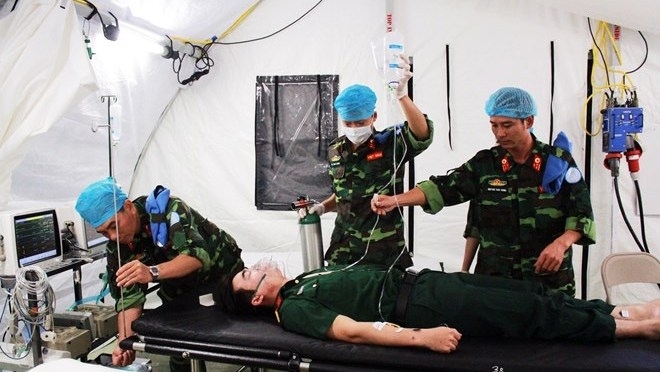
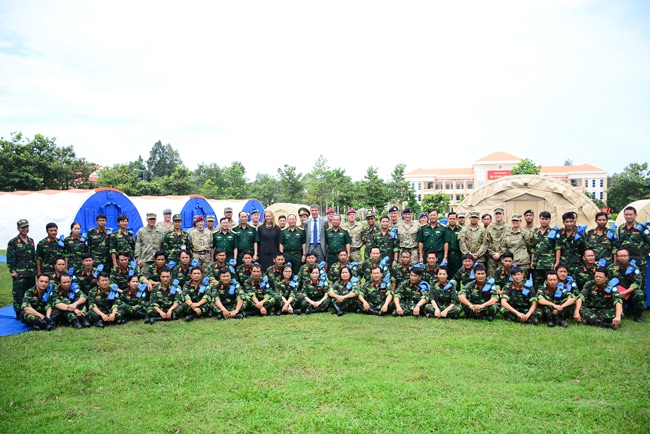
Training exercise for the Vietnam Peacekeeping Center (VPC), Military Hospital 175, and the Department of Military Medicine under the Vietnam Ministry of Defence in association with the United States Pacific Command (USPACOM, now USINDOPACOM) prepares officers for the successful deployment and operation of a Level-2 field hospital purchased from BLU-MED®.
